A Spring 2004 Semester Of Lehigh Birds
In
the Spring Semester of 2004, we walked a set route around campus from
9 AM to 10 AM every Wednesday in order to count the birds seen on campus.
The time and route were kept constant so that the only variation in what
we observed would come from the movements of birds based on seasonal variation.
The purpose of this data is to give a general idea of the types of bird
life seen on campus as well as the seasonal variation in these birds numbers.
The route was chosen in areas commonly trafficked by students so that
the birds we were seeing would also be those easily seen by students en
route in daily life. The route is mapped below...
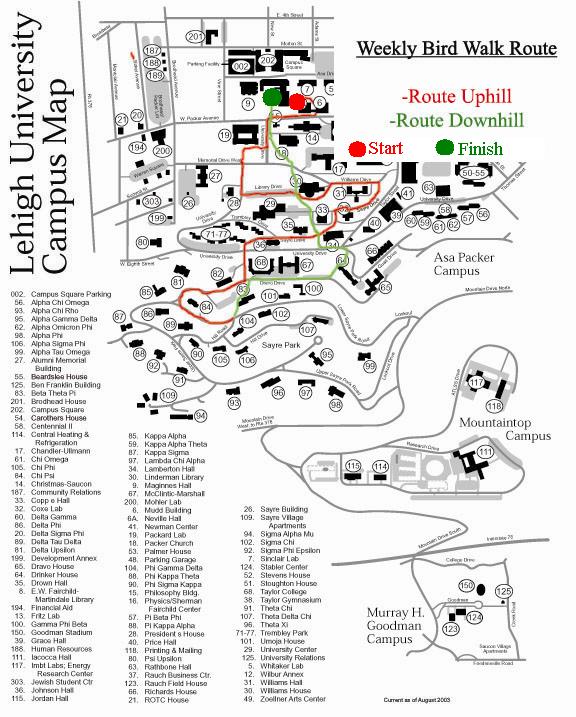 |
Walks were started in March and continued until the end of the Spring semester. February bird observations are not included because we had not yet established a set route and since February is still midwinter, movement among birds is minimal with observed species consistently similar to those seen in the early March observations. |
|
Observed
Birds 3/3/04
|
 Coopers Hawk |
| Comments: As expected with winter still full strength in the Lehigh Valley, the birds we saw today were typical winter species. Most of the birds observed (American Cardinals, American Crows, Downy Woodpeckers, Mourning Doves, and House Sparrows) are non-migratory and make small (if any) seasonal movements. They become more noticeable in winter because they become one of the few species around. The White-throated Sparrow and Dark-eyed Junco are also common winter birds but their presence here is evidence of migration. Both of these birds are only found in here in the winter, when they migrate south from their more northern breeding grounds. Just as some birds are seen as harbingers of spring, many people see the Junco as a "snowbird" indicating the coming of winter. The Coopers Hawk is also a bird that migrates, but this individual here most likely has not. Although many Coopers Hawks do truly migrate (they make up a good portion of the impressive fall raptor migration) many also make only small movements or stay year round in an area. I have seen a Coopers Hawk many times in the Fall and throughout Winter on campus and, although it is possibly a different bird, the frequency of times I have seen it indicates it is a local bird. This particular hawk has probably found an area where he is thriving and as such no longer needs to migrate to survive. The fact that he was observed with a bird in his talons today is evidence that this bird is surviving comfortably on campus throughout the winter. |
 Black-capped Chickadee |
Observed
Birds
|
Comments:
As was also
the case last week the birds around campus tended to be unevenly dispersed.
There were times when we walked for 15 minutes without seeing or hearing
a single bird. We would then come across four or five birds often of different
species in the same group of trees. The fact that birds (especially birds
like chickadees, titmouse, and nuthatches) form mixed flocks in winter
is well known and seems to be demonstrated here. The birds this week and
last also showed the winter tendency to hang out around bird feeders.
The majority of the birds seen these past two weeks were focused in front
of Packard where there is a bird feeder hanging from one of the windows.
The Coopers Hawk was still around as well, indicating further that there
is a local Coopers Hawk living near campus.
| Observed
Birds 3/17/04
|
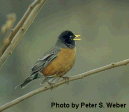 American Robin |
Comments:
The first Robins we have seen were observed today. While these birds are
migratory, they may also stay overwinter, or more northern individuals
may migrate to our area during the winter. So the American Robins is not
a fool-proof harbinger of spring. Since Robins form large winter flocks,
the size of the flock seen here leads me to believe that most Robins have
not migrated back yet, but that instead we just happened to run into a
large wintering flock of Robins. The Coopers Hawk was not seen but the
similar, smaller Sharp-shinned Hawk was observed. A fly-by Ring-billed
Gull was an interesting sight since most people associate gulls with coastal
ecosystems. The Ringed-bill has adapted very well to humans, however,
and has moved inland living in areas like parking lots. Most of the birds
seen today were found in the Drown-M+M area. The Blue Jays were also a
welcome sight. Because they are so common it is often easy to overlook
this gaudy bird, but taking a close look reveals it to be one of the most
impressively colored North American birds.

Common Grackle |
Observed
Birds 3/24/04
|
| Comments: A much warmer day today, and the most diverse bird life we have seen thus far, indicate that the spring is on its way. The Robins were seen again today but they were acting much more like spring Robins than last week. They were sitting as individuals or in small groups mostly on lawns instead of as one large group in a tree as was the case last week. The appearance of a Common Grackle is even more encouraging, as this blackbird is also mostly migratory (only a few remain all year). The American Goldfiches were still mostly in winter plumage but a few individuals seemed to be molting into breeding plumage. |
| Observed
Birds 3/31/04
|
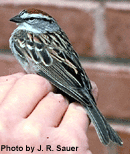 Chipping Sparrow |
| Comments:
Much
worse weather than last week, back to cold and a little drizzly.
Despite the un-springy conditions another sign of spring was observed
for the first time today. A Chipping Sparrow was calling in the
pine tree in the island between Williams and Taylor Gym! This
is the most indicative spring migrant seen yet. Winter birds are
still around, however, as seen by the presence of a White-throated
Sparrow. The birds are showing the variation in times of movement
for species.The Chipping Sparrow has already reached its summer
breeding grounds, while the White-throat has yet to start its
migration back north. |
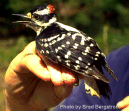
Downy Woodpecker |
Observed
Birds 4/7/04
|
| Comments: Nothing too new and exciting for today's count. The arrival of more Chipping Sparrows was encouraging, and the amount of bird songs in the air has greatly increased. For some reason only one House Sparrow was seen, this if nothing else indicates the unpredictable nature of birds. Interestingly one Chipping Sparrow was heard from the same tree as last week and may the same individual setting up a nesting territory there. |
| Observed
Birds 4/14/04
|
 Yellow-rumped Warbler 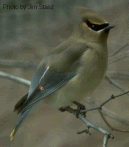 Yellow-bellied Sapsucker |
| Comments: A good day for birds! The most interesting finds were the Yellow-bellied Sapsucker and the Yellow-rumped Warbler. These two birds are migratory opposites; the Sapsucker migrates here in winter while the Warbler is a spring migrant. Despite this these two birds were seen not two trees apart. The bird season is still in a stage of transition, but the arrival of the Yellow-rumped Warbler is a precursor to the other spring warblers to follow. We can expect winter migrants to disappear completely and the colorful spring migrants to arrive within a few weeks. Some like the Yellow-rumped may or may not spend the summer in our area, others will only come through only in passing and continue on to more northern breeding grounds. |
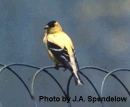
American Goldfinch |
Observed
Birds 4/21/04
|
| Comments: Today was the last walk to be completed before the end of the semester and the spring bird calls were loud and abundant. Although we could only safely count 8, the chipping sparrows were a constant chatter on campus. We also saw the first fully spring plumaged American Goldfinch. Although not really a spring migrant, a flyby Red-shouldered Hawk was a nice final reminder of the diversity of bird life that can be seen on campus. |